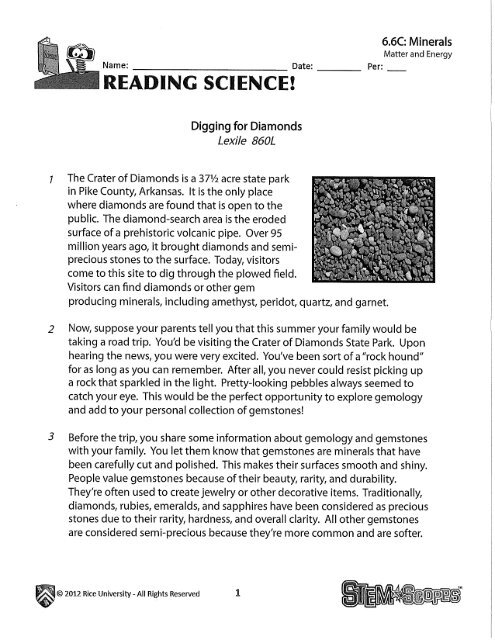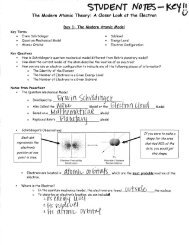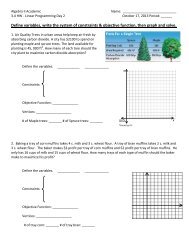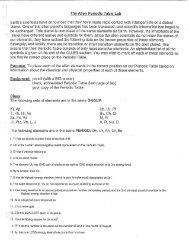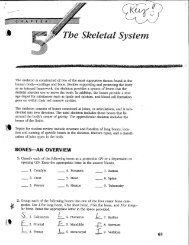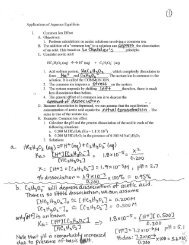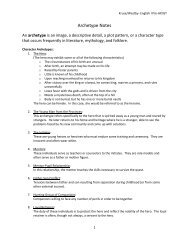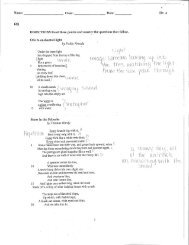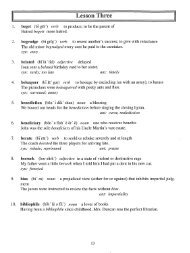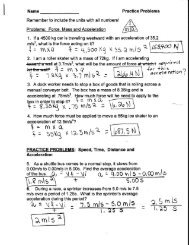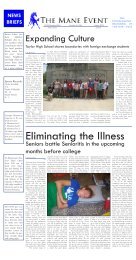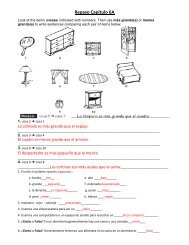READING SCIENCE!
READING SCIENCE!
READING SCIENCE!
Create successful ePaper yourself
Turn your PDF publications into a flip-book with our unique Google optimized e-Paper software.
Name: Date:<br />
<strong>READING</strong> <strong>SCIENCE</strong>!<br />
Digging for Diamonds<br />
Lexile 860L<br />
The Crater of Diamonds is a 371/2 acre state park<br />
in Pike County, Arkansas. It is the only place<br />
where diamonds are found that is open to the<br />
public. The diamond-search area is the eroded<br />
surface of a prehistoric volcanic pipe. Over 95<br />
million years ago, it brought diamonds and semiprecious<br />
stones to the surface. Today, visitors<br />
come to this site to dig through the plowed field.<br />
Visitors can find diamonds or other gem<br />
producing minerals, including amethyst, peridot, quartz, and garnet.<br />
Per:<br />
6.6C: Minerals<br />
Matter and Energy<br />
2 Now, suppose your parents tell you that this summer your family would be<br />
taking a road trip. You'd be visiting the Crater of Diamonds State Park. Upon<br />
hearing the news, you were very excited. You've been sort of a "rock hound"<br />
for as long as you can remember. After all, you never could resist picking up<br />
a rock that sparkled in the light. Pretty-looking pebbles always seemed to<br />
catch your eye. This would be the perfect opportunity to explore gemology<br />
and add to your personal collection of gemstones!<br />
3 Before the trip, you share some information about gemology and gemstones<br />
with your family. You let them know that gemstones are minerals that have<br />
been carefully cut and polished. This makes their surfaces smooth and shiny.<br />
People value gemstones because of their beauty, rarity, and durability.<br />
They're often used to create jewelry or other decorative items. Traditionally,<br />
diamonds, rubies, emeralds, and sapphires have been considered as precious<br />
stones due to their rarity, hardness, and overall clarity. All other gemstones<br />
are considered semi-precious because they're more common and are softer.<br />
© 2012 Rice University - All Rights Reserved
<strong>READING</strong> <strong>SCIENCE</strong>! 6.6C: Minerals<br />
Matter and Energy<br />
Lots of semi-precious stones are very popular. They can be used to create<br />
beautiful jewelry. You tell your family to be on the lookout for the more<br />
common semi-precious stones found at Crater of Diamonds.<br />
4 As the big trip gets closer, everyone in your family is getting excited about<br />
visiting the Crater of Diamonds. You've decided that the time has come to<br />
share the most important information with your family: how to spot a<br />
diamond. After all, it's important to know whether they've found a diamond,<br />
or just a plain old rock. You share that four physical properties are used to<br />
identify a mineral. These are hardness, color, luster, and streak.<br />
5 Hardness describes the strength of the forces holding atoms together in a<br />
solid mineral. The Mohs scale is used to describe how easily a mineral can be<br />
scratched. It has a range from 1-10. Diamonds are rated a 10 on the Mohs<br />
scale. They are the hardest minerals in the world. The color of a mineral is<br />
often easy to identify. Many minerals are found in a wide range of colors.<br />
Diamonds are no exception. They can be yellow, brown, blue, green, orange,<br />
purple, black, pink, red, or colorless. Colored diamonds have impurities that<br />
cause them to be different colors. Colorless, transparent diamonds, however,<br />
are nearly pure. Luster refers to the way a mineral reflects the light. A<br />
mineral's luster could be metallic, dull, pearly, or adamantine. Diamonds<br />
have adamantine luster, which is seen in their brilliant sparkle. The term<br />
streak refers to the color of the powder left by a mineral. The streak of a<br />
mineral is often found by scraping a mineral along the non-glazed side of a<br />
porcelain tile. The color of the mark left on the tile helps to identify the<br />
mineral. The streak of a diamond is white.<br />
6 You've explained how a mineral's physical properties can be tested to identify<br />
it. You also tell them that some of these tests work better in a laboratory.<br />
Now that your family knows how physical properties are used to identify<br />
minerals, they're even more excited to dig up some hidden gems. As<br />
summer gets closer, you and your family are getting more and more excited<br />
about your trip to the Crater of Diamonds. Who knows what treasures you'll<br />
fin!!<br />
© 2012 Rice UniVersity - All Rights Reserved 2
<strong>READING</strong> <strong>SCIENCE</strong>! 6.6C: Minerals<br />
Matter and Energy<br />
2<br />
Paragraph 5 of this passage mainly<br />
tells about-<br />
A the physical properties of<br />
minerals.<br />
B<br />
C<br />
how to spot a diamond.<br />
determining how rare a<br />
diamond is.<br />
D how to test a diamond for value.<br />
Complete the following analogy.<br />
Mohs scale: hardness<br />
A Metallic: luster<br />
B Porcelain tile: streak<br />
C Cost:diamond purity<br />
D Colored diamond:clear<br />
diamond<br />
© 2022 Rice University- All Rights Reserved 3<br />
You can tell from reading this<br />
passage that --<br />
A the narrator will definitely find a<br />
diamond at the Crater of<br />
Diamonds State Park.<br />
B diamonds are rare, valuable<br />
gems.<br />
C garnet is as valuable asa<br />
diamond.<br />
D semi-precious stonesare ugly.<br />
4 Complete the following analogy.<br />
Semi-precious: amethyst<br />
A Diamond: clear<br />
B Rare: diamond<br />
C Precious: diamond<br />
D Diamond: adamantine
<strong>READING</strong> <strong>SCIENCE</strong>!<br />
5 A Mohs scale is used to determine<br />
of a mineral.<br />
A luster<br />
B hardness<br />
C monetary value<br />
D streak<br />
© 2012 Rice University - All Rights Reserved 4


